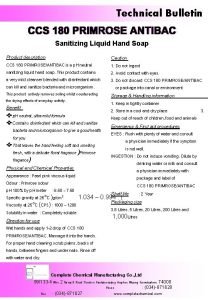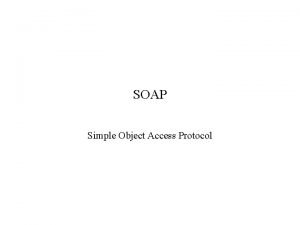The Effect of Hand Sanitizer and Hand Soap









- Slides: 9

The Effect of Hand Sanitizer and Hand Soap Use on Infection Control Mikayla Shockley, Ashley King, & Danielle Eskow

Research Question ● How does the use of hand sanitizer and hand soap help prevent the spread of infection throughout the hospital environment? ● Which one is more effective in preventing the spread of infection?

Chain of Infection ● To stop the spread of infection, break any part of the links in the chain of infection. One of the ways to break this chain is by washing one's hands to prevent the spread. ● The Chain of Infection includes Infectious Agent or Pathogen, Reservoir, Portal of Exit, Transmission, Portal of Entry, and Host Susceptibility (Perry. A, Potter, P. , & Ostendorf, W. , 2018).

Alcohol Based Hand Sanitizer ● Can be used in most cases as long as hands are not visibly soiled. ● It is a quicker procedure than hand washing and is tolerated better by skin (Dehrun et al. , 2018). ● It is easily accessible compared to finding an available sink with soap. ● Can be found inside patients rooms on walls near entrance, outside rooms in hallways, in break rooms, at the entrance of the hospital, and at nurses stations (Munoz-Figueroa, G. , & Ojo, O. , 2018). ● Must be applied correctly for it to be effective (Perry, Potter, & Ostendorf, 2018

Antimicrobial Hand Soap ● Should be used when hands are visibly soiled or contaminated with blood/bodily fluids. ● Must be done properly in order to wash away bacteria and prevent recontamination of clean hands (Perry, Potter, & Ostendorf, 2018). ● Amount of time spent washing hands directly reflects if there is reduction in bacteria/contamination of hands (Dehrun et al. , 2018). ● Is more irritating to skin than hand sanitizer since it does not contain emollients.

Research Findings for Alcohol Based Hand Sanitizer ● Estimated infection rate reduction of 17. 5% when product is available at bedside (Munoz-Figueroa, G. , & Ojo, O. , 2018). ● Helps lower the spread of GI infections in the hospital as well as in home/child care environments (Munoz-Figueroa, G. , & Ojo, O. , 2018) ● “Alcohol-based hand sanitizer is more effective and less drying than using soap and water, and does not create antibiotic-resistant superbugs” (CDC, 2020).

Research Findings for Hand Soap ● Use of hand soap is recommended after caring for patients who have C. difficile and then followed by hand sanitizer. This helps reduces the number of C. difficile infections (Munoz-Figueroa & Ojo, 2018). ● Handwashing with plain soap can result in paradoxical increases of bacterial count on the skin (Perry, Potter, & Ostendorf, 2018). ● Hand soap is more effective than hand sanitizer at removing certain germs like Cryptosporidium, norovirus, and C. difficile (CDC, 2020). C. difficile

Conclusion ● Performing hand hygiene by using alcohol-based hand sanitizer or antimicrobial hand soap helps to prevent infections. ● Hand hygiene is especially important in hospitals, where patients bring in microorganisms that have the potential to spread to other patients and healthcare workers. ● When comparing hand soap to hand sanitizer, we concluded that hand sanitizer is more effective, convenient, and accessible. ● The exceptions for hand hygiene when using hand sanitizer are C. difficile, Cryptosporidium, and norovirus. ● Both hand soap and hand sanitizer have pros and cons

References ● ● ● Centers for Disease Control and Prevention. (2020). Clean Hands Count for Safe Healthcare. Retrieved from https: //www. cdc. gov/patientsafety/features/clean-hands-count. html Centers for Disease Control and Prevention. (2020). Show Me the Science – When & How to Use Hand Sanitizer in Community Settings. Retrieved from https: //www. cdc. gov/handwashing/show-me-the-sciencehand-sanitizer. html Perry, A. , Potter, P. , & Ostendorf, W. (2018). Clinical nursing skills & techniques. (pp. 243 -246) St. Louis, MO: Elsevier. Derhun, F. , Souza, V. , Costa, M. , Hayakawa, L. , Inoue, C. , & Mastuda, L. (2018). Use of alcohol based hand sanitizer for hand hygiene. Journal of UFPE/ Revista de Enfermagem UFPE, 12(2), 320 -328. doi: http: //dx. doi. org. proxy. longwood. edu/10. 5205/1981 -8963 -v 12 i 2 a 23095 p 320 -328 -2018 Tortorice, J. (2017). Breaking the chain of infection. Retrieved from https: //ceufast. com Munoz-Figueroa, G. , & Ojo, O. (2018). The effectiveness of alcohol-based gel for hand sanitising in infection control. British Journal of Nursing, 27(7), 382 -388. doi: http: //dx. doi. org. proxy. longwood. edu/10. 12968/bjon. 2018. 27. 7. 382
















